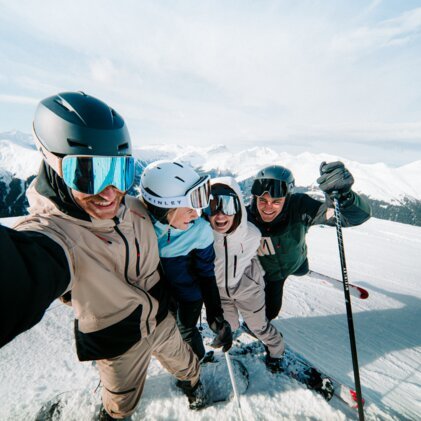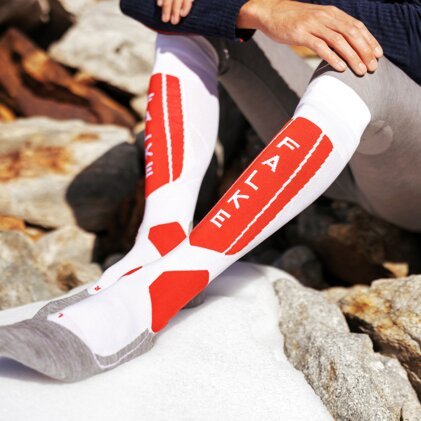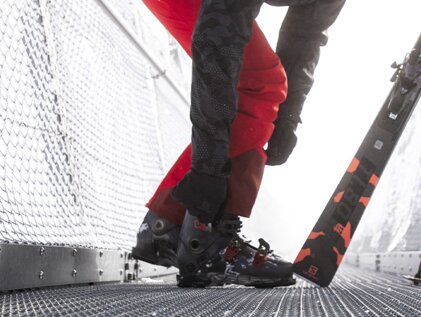
"These boots are made for walking ..." - or not! At least you probably doubted it the last time you stumbled across the terrace of a ski hut in your ski boots. We've all been there: ski boots do a great job on the slopes. But when you want to get from A to B on foot, it's a different story. GripWalk technology is a development that aims to do just that.
In this blog post, we take a look at the GripWalk binding and the corresponding sole. We explain what this is all about, what advantages the system offers and how it is compatible with other systems.
The GripWalk sole
There are two options for the standard sole: Either it is already integrated directly into a GripWalk boot, or it can be retrofitted separately. You can also use matching pads for your alpine ski boots.
The system itself consists of a pair, whereby each sole is divided into two parts and is made up of a ball of the foot and heel piece. The sole has a profiled hard rubber part, which provides the necessary cushioning when walking, while an associated part made of hard plastic guarantees a firm connection to the GripWalk binding.
GripWalk soles ...
- have a cambered and grooved rubber profile.
- have a slightly rockered (bent forward) sole, which supports the natural rolling movement.
- have special anti-slip strips.
- guarantee a firm grip on slippery surfaces.
All this makes walking in ski boots more comfortable, as the foot can roll naturally. But GripWalk soles have even more benefits!
What are the advantages of GripWalk soles?
As mentioned above, with GripWalk soles you no longer tend to stomp. They are therefore a great help when balancing the trays in the hut. The following advantages make them a real asset for winter sports fans:
- Improved safety: With normal ski boots, walking on slippery surfaces can sometimes turn into a dangerous ride. Thanks to the heavily ribbed profile and anti-slip material, GripWalk soles give you better performance on difficult grounds.
- More comfort: The ergonomic shape of the soles ensures a natural rolling behaviour of the foot - and therefore more safety when walking.
- Optimum performance when riding: GripWalk soles offer excellent power transmission and precise release. This makes them a real asset on and off the slopes.
- Easy to use: Getting on and off works exactly the same with GripWalk bindings as with normal bindings - no need to get used to them!
- Durability: The replaceable sole components can be quickly replaced when the tread is worn out.
Everything you need to know about the GripWalk binding
The GripWalk binding offers the perfect counterpart to the sole. A safety tip first: always make sure that the ski binding and sole are compatible. As the binding is a safety feature, it must be guaranteed that it will release and free the ski boot in the event of a fall.
GripWalk bindings ...
- have a slightly rockered glide plate, which makes them compatible with all GripWalk soles.
- offer the same functionality as conventional binding systems.
The combination of a compatible sole and binding ensures that both safety and performance are maintained when skiing. If you have any questions, ask the RENTertainers in one of our shops.
Advantages of GripWalk bindings at a glance
- Maximum compatibility: GripWalk alpine bindings are compatible with both GripWalk soles (ISO standard 23223) and alpine ones (ISO standard 5355).
- Release behaviour: GripWalk bindings comply with the same safety standards as all other standardised systems.
- Comfort: Thanks to the binding-sole combination, you no longer have to adjust the height of the gliding plate of your ski binding to ensure compatibility with other types of soles.
Retrofitting new ski boots or GripWalk only: What options are there?
If you are convinced by the standard, you have the following possibilities when changing the system:
- You buy new ski boots with GripWalk soles already integrated.
- You buy or own a ski boot on which the corresponding GripWalk sole can be retrofitted over the entire surface instead of the alpine sole. A logo on the outside of the boot usually indicates this.
- There are separate GripWalk inserts for the ball of the foot and heel, which are fitted to the existing alpine sole. Only the pads at critical contact points are replaced without having to change the entire sole. These inserts comply with ISO standard 23233, which describes alpine ski boots with improved outsoles.
Tip: GripWalk soles must be fitted by authorised experts, as the necessary adjustments have a direct impact on the release of your binding in the event of a fall. Our ski service also includes fitting the system and setting the appropriate Z-value - all tailored to your weight, height, ability and skiing style.
The world of standards is quite complicated, which is why it is important that your equipment works. The skis must match the bindings and the bindings must also match the ski boots. Let's take a look at the compatibility of the systems in relation to GripWalk technology.
Which GripWalk bindings are compatible with which soles and vice versa?
First of all: GripWalk is a standard that was introduced in 2016 and brought to the customer for the 2017/2018 winter season. Since then, more and more manufacturers have integrated the new standard into their products. Although a large number of suitable systems are now available, you should still take a close look if you are going out on your own to avoid unnecessary costs. In this context, we have answered a few questions about bindings and alpine and touring ski boots for you:
Can I continue to use a conventional alpine binding with my GripWalk ski boot (whether retrofitted or integrated)?
No, when switching to a GripWalk sole (ISO 23223), a suitable GripWalk binding is mandatory. The optimised glide plate guarantees a firm fit, comfort, performance and safe release.
Can I use a conventional alpine binding with my touring ski boot (ISO standard 9523)?
No, this is not possible. Standard 9523 describes the requirements and test procedures for adult touring ski boots. Make sure that the ski touring binding is labelled "MN" + "A".
If you need advice on the different systems, our RENTertainers, the experts at INTERSPORT Rent, will be happy to help you. Thanks to the on-site ski rental, you also have the option of testing GripWalk boots and combinations with the right skis and bindings to see the benefits for yourself. We look forward to your visit.
Frequently asked questions about GripWalk bindings
How do I recognise GripWalk boots?
In contrast to conventional ski boots with a flat sole made of hard plastic, GripWalk boots primarily stand out due to their profiled and rubberised sole. In most cases, a logo on the outside also indicates that these are ski boots with this technology.
How can I recognise a GripWalk binding?
It is difficult for the untrained eye to recognise whether a binding is compatible with GripWalk or not. In most cases, a label in front of or on the curved glide plate indicates that it is the corresponding system.
Can I repair my ski boot sole with hot glue?
You should have your ski boots repaired by an expert. Damage to the outer shell or sole can severely impair the stability of the ski boot. This has an impact on performance and safety. The trained service staff at INTERSPORT Rent can repair any damage with special adhesives and thermal moulding, as used in boot fitting.
INTERSPORT Rent tip
The RENTertainer recommends
Thanks to the GripWalk standard, walking in ski boots is a lot more comfortable than before. However, this doesn't necessarily mean that you have to run straight to the nearest shop to buy new a new pair. However, if you regularly have problems handling ski boots, it's worth trying out a suitable set-up for a day.
Our local experts will be happy to explain the technology to you and give you honest feedback on whether a change is worthwhile in your situation. And even if you decide not to upgrade at this stage, you'll know what to ask for next time. We look forward to your visit at INTERSPORT Rent.
Related articles
You may also be interested in:



